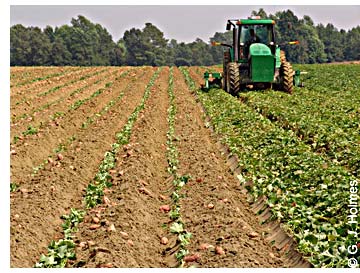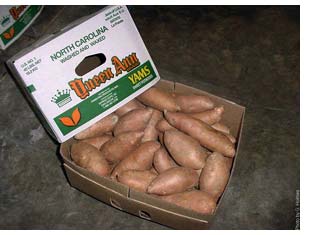New EQIP Cost-Share Helps Sweetpotato Producers Adopt IPM
 A new conservation cost-share, offered through the Environmental Quality Incentive Program (EQIP), is the first targeted specifically for sweetpotato production in North Carolina. As a result the sweetpotato farmers in North Carolina will be able to dramatically reduce their use of foliar insecticides, cut input costs, and make fewer trips over the field while still producing quality crops. This new opportunity was made possible by a cooperative effort of North Carolina State University and Cooperative Extension, the NC Sweetpotato Commission, and the Natural Resources Conservation Service (NRCS), led by the Center for Agricultural Partnerships.
A new conservation cost-share, offered through the Environmental Quality Incentive Program (EQIP), is the first targeted specifically for sweetpotato production in North Carolina. As a result the sweetpotato farmers in North Carolina will be able to dramatically reduce their use of foliar insecticides, cut input costs, and make fewer trips over the field while still producing quality crops. This new opportunity was made possible by a cooperative effort of North Carolina State University and Cooperative Extension, the NC Sweetpotato Commission, and the Natural Resources Conservation Service (NRCS), led by the Center for Agricultural Partnerships.
The pests being targeted—wireworms and flea beetles—cause major economic damage. Growers have been applying both a pre-plant soil insecticide and as many as 7-10 foliar sprays during the growing season to control them. Under the new "IPM Strategy for Sweet Potatoes", participating growers may apply a pre-plant soil incorporated insecticide to reduce wireworm and flea beetles. They may also apply one or two soil-incorporated insecticides at cultivation. These soil-incorporated applications will replace the need for foliar application during the main part of the growing season. Then, in the late season, fields will be scouted for the presence of foliage-feeding Lepidoptera. Participants can only apply foliar insecticides when a high threshold of damage has been reached, and then, only use reduced risk products. Scouting can be done either by the grower or by a consultant employed by the grower. Documentation is required of applications and scouting. The payment to growers is $19.00 per acre, and includes costs for field scouting and use of reduced-risk materials.
This is a big change from the practices—and recommendations—that growers have followed for years. However, on-farm research spearheaded by the Southern Sweetpotato IPM Project over the last three years has clearly shown that only soil treatments have any benefit. Treating the adult insects on the foliage later in the season has no effect on the damage the juvenile stages cause on the potatoes themselves. NC State University researchers have been conducting this research on the farms of 16 cooperating farmers as part of a five-year project funded through USDA's Cooperative Research, Extension and Education Service and Gerber Products Company. The ongoing project is tackling a broad range of pest management concerns, including disease and weed management and post-harvest handling; it involves growers, processors, and researchers in North Carolina, Louisiana, Mississippi and Alabama.
According to NC State University Entomologist George Kennedy, most growers have already been using the pre-plant treatment for wireworm and flea beetle. But research indicates that the treatments at cultivation by themselves provide sufficient protection without foliar sprays. The Lepidoptera pests that appear later in the season tend to make the leaves look bad late in the season, but rarely cause economic damage except at very high thresholds. Thus, scouting provides a good way of determining whether insecticides are needed, and reduced risk options provide the necessary control for the pests at that time of the year.
 This new EQIP cost share was approved in November 2006, so initial sign-up in 2007 is likely to be minimal. However, growers have been learning about the new recommendations and the incentive cost share at recent meetings. According to Jennifer Curtis, Project Outreach & Evaluation Coordinator, "The reaction has been positive and growers seem excited. Those who have been participating in the research and have seen the results in test plots on their own land will likely be the first to sign up." Says producer Allen Rose, "It looks like a good thing. We plan to sign up 250 acres out of our 500. We're just waiting on soil tests so we know which fields to tell them we'll be planting on."
This new EQIP cost share was approved in November 2006, so initial sign-up in 2007 is likely to be minimal. However, growers have been learning about the new recommendations and the incentive cost share at recent meetings. According to Jennifer Curtis, Project Outreach & Evaluation Coordinator, "The reaction has been positive and growers seem excited. Those who have been participating in the research and have seen the results in test plots on their own land will likely be the first to sign up." Says producer Allen Rose, "It looks like a good thing. We plan to sign up 250 acres out of our 500. We're just waiting on soil tests so we know which fields to tell them we'll be planting on."
Many sweetpotato producers, like most fruit and vegetable producers, have had little contact with state and federal conservation programs. The perception—and the reality—has been that programs and payments are going to livestock and row crops. If anything, sweetpotato growers are more aware of these programs than other vegetable producers, since they tend to have larger acreage and other crops, and some, like Allen Rose, have used federal conservation programs such as EQIP on their other acreage or rotation crops, such as soybeans or small grains.
The development of this new NRCS cost share is part of a project to expand North Carolina fruit and vegetable producers' access to conservation programs by increasing awareness of conservation programs among growers, educating conservation staff about the needs and practices of these growers, and developing new programs targeted to specialty crop producers. This project, led by the Center for Agricultural Partnerships in cooperation with NRCS, NCSU, and grower groups, has also developed new cost share programs for strawberry and vegetable growers. As these growers who've never before had contact with NRCS walk through the door because they've heard about new programs specifically for these crops, they also may benefit from help with conservation planning for their farms and find that they also qualify for other existing programs.
Putting the Farm Bill to Work Quick Links
- Appalachian Region
- California
- Georgia
- Michigan
- North Carolina
- North Carolina Apple Growers
- North Carolina Nursery Crops
- North Carolina Christmas Trees
- North Carolina Strawberry Growers
- North Carolina Strawberry Survey
- North Carolina Sweetpotato Producers
- North Carolina Sweetpotato Survey Summary
- Western North Carolina Vegetable Growers
- Oregon

